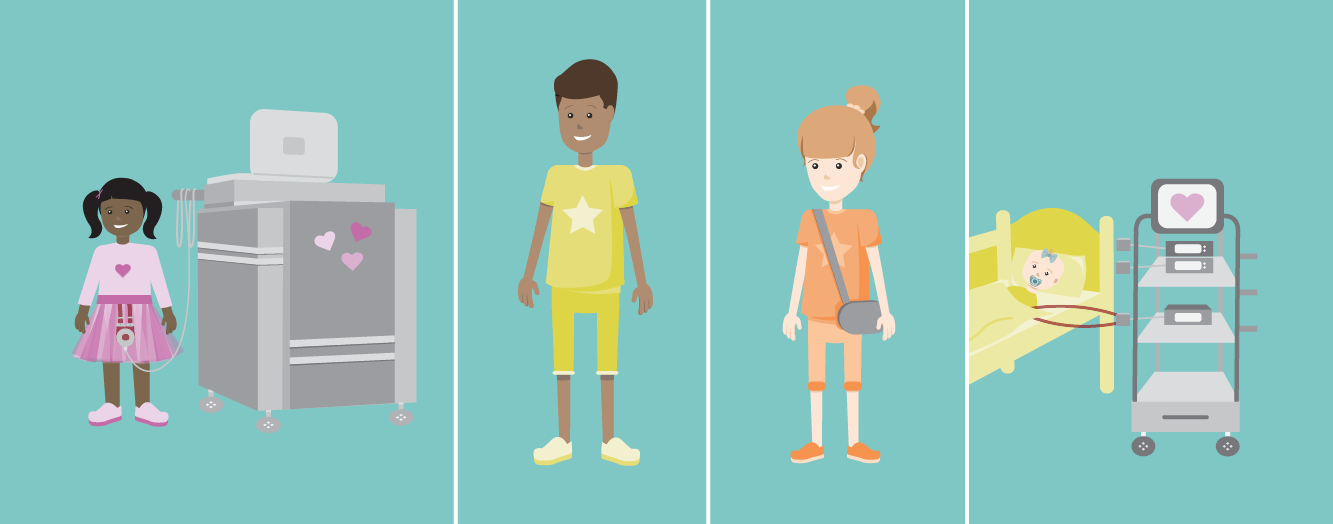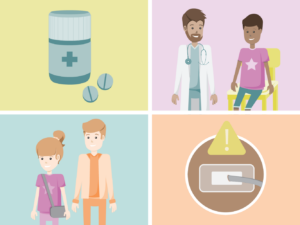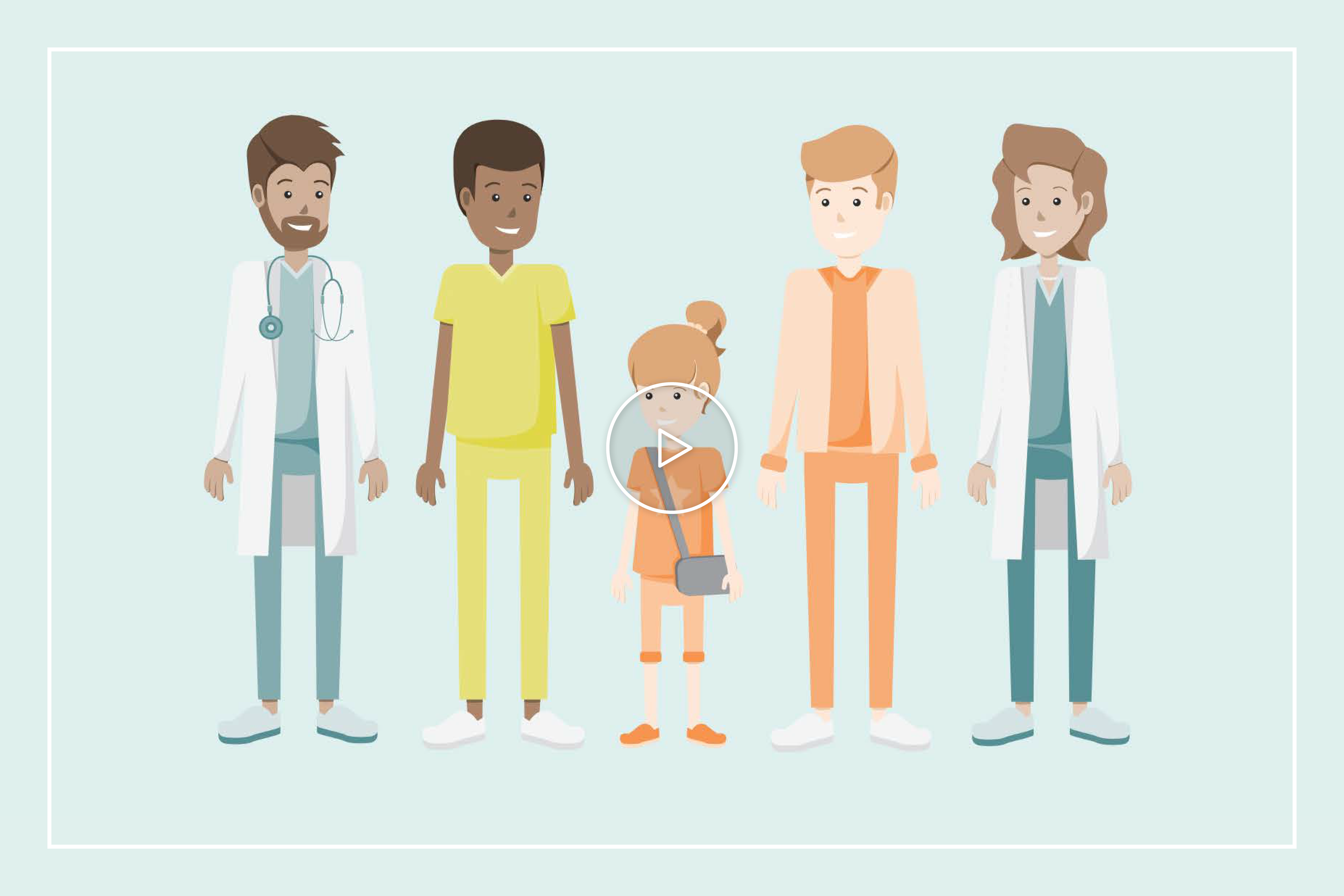What Are VADs?
VAD stands for “Ventricular Assist Device.” A VAD is a pump surgically placed in a sick or weak heart to help deliver blood to the body. Children may need a VAD because they are born with a heart problem or because one develops over time.
Children with heart failure often have symptoms like feeling short of breath, having trouble eating or gaining weight, and having low energy. A VAD may help these symptoms get better. Sometimes a VAD, depending on the type, will help you feel well enough to leave the hospital and return to school or work.

The Care Journey
Let’s take a look at your care journey with a VAD.
Meet the Care Team
There are many people that will care for you during your VAD journey, but your care team will guide you throughout the entire journey and always help you make decisions about your care. Just remember, you and your caregivers are a very important part of the team. Your care team may include:
- Cardiac Surgeon
- Heart Failure Doctor
- VAD Coordinator
- Nurse Practitioner
- ICU Doctor
- Nurse(s)
- Physical Therapist (PT)/ Occupational Therapist (OT)
- Psychologist
- Cardiac Rehabilitation Specialist
- Nutrition Specialist
- Pharmacist
- Child Life Specialist
- Social Worker


Where is the VAD Implanted?
VADs can be implanted in any chamber of the heart, but usually they’re located in the left ventricle. The location of the device determines what your VAD may be called.
- LVAD: A left ventricular device implant, or LVAD, is implanted in the left ventricle of the heart. It improves blood flow to the entire body. (HeartMate 3™ and HVAD System™ are only approved by the FDA for left ventricle support.)
- RVAD: A right ventricular device implant, or RVAD, is implanted in the right ventricle of the heart. It improves blood flow to the lungs.
- SVAD: A systemic assist device is for patients who were born with only one working ventricle. A VAD is implanted into the “systemic” ventricle that pumps blood to the body.
- BiVAD: A biventricular assist device, or BiVAD, is implanted in both ventricles of the heart.
Benefits
Risks
Benefits

A VAD may be used to help a heart pump for many reasons. Depending on your situation, a VAD may be used as a:
- Bridge to Transplant: To support the heart until the best donor heart is available for transplant.
- Destination or Chronic Therapy: To support the heart, decrease heart failure symptoms and improve overall quality of life.
- Bridge to Recovery: To support the heart if there is a chance the heart will recover.
- Bridge to Decision: To support the heart until a decision can be made by the family and medical team regarding next steps (surgeries or medications).
Risks

Although rare, complications may occur while living with a VAD, which may include:
- Stroke: With all VADs there is a risk of stroke, which is caused by bleeding or a blood clot in your brain. Both may cause injury to your brain. Your care team manages your medicines carefully to prevent strokes, however sometimes strokes may occur.
- Bleeding: While on a VAD, you will take blood thinners which may increase your risk of bleeding. When on blood thinners, you are always at risk of bleeding. Nose bleeds, bruising, and bleeding in your stomach may occur.
- Infection: The driveline or cannulas are directly connected to the heart and lead outside the body through the skin, making infection a risk. If the device or driveline gets infected, you may need to take antibiotics. You will have frequent dressing changes of your central lines and your driveline to help prevent infection.
Reducing VAD Risks
Although the complications above sound scary, there are many steps you and your care team will take to reduce the possibility of complications. VAD patients will:
- Take blood thinners and other medicines to help their heart
- Have frequent visits to the doctor to make sure the VAD is working right
- Have a caregiver who understands how the pump works
- Change the bandages and clean the area where parts of the pump come through the skin
Resources
Hearts & Minds: Neurodevelopment in Patients with Heart Failure & VADs
See Health & Wellness > Life Style > Resources

A VAD may be used to help a heart pump for many reasons. Depending on your situation, a VAD may be used as a:
- Bridge to Transplant: To support the heart until the best donor heart is available for transplant.
- Destination or Chronic Therapy: To support the heart, decrease heart failure symptoms and improve overall quality of life.
- Bridge to Recovery: To support the heart if there is a chance the heart will recover.
- Bridge to Decision: To support the heart until a decision can be made by the family and medical team regarding next steps (surgeries or medications).

Although rare, complications may occur while living with a VAD, which may include:
- Stroke: With all VADs there is a risk of stroke, which is caused by bleeding or a blood clot in your brain. Both may cause injury to your brain. Your care team manages your medicines carefully to prevent strokes, however sometimes strokes may occur.
- Bleeding: While on a VAD, you will take blood thinners which may increase your risk of bleeding. When on blood thinners, you are always at risk of bleeding. Nose bleeds, bruising, and bleeding in your stomach may occur.
- Infection: The driveline or cannulas are directly connected to the heart and lead outside the body through the skin, making infection a risk. If the device or driveline gets infected, you may need to take antibiotics. You will have frequent dressing changes of your central lines and your driveline to help prevent infection.
Reducing VAD Risks
Although the complications above sound scary, there are many steps you and your care team will take to reduce the possibility of complications. VAD patients will:
- Take blood thinners and other medicines to help their heart
- Have frequent visits to the doctor to make sure the VAD is working right
- Have a caregiver who understands how the pump works
- Change the bandages and clean the area where parts of the pump come through the skin
